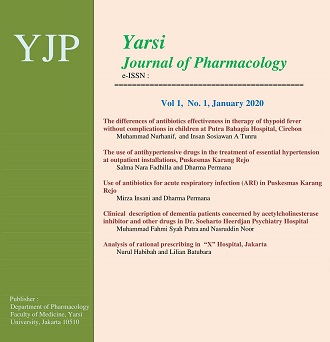Use of Antibiotics for acute respiratory infection (ARI) in Puskesmas Karang Rejo, Tarakan
Kata Kunci:
Antibiotics, Acute respiratory infection, ARI, PuskesmasAbstrak
Background: Acute respiratory infection (ARI) is a serious infection that prevents normal breathing function. It usually begins as a viral infection in the nose, trachea (windpipe), or lungs. If the infection is not treated, it can spread to the entire respiratory system. ARI prevents the body from getting oxygen and can result in death. ARI is the most common diagnosis for which antibiotics are prescribed and there are many reasons why primary care doctors prescribe antibiotics. The aim of this study was to know the use of antibiotic drugs in ARI patients at Puskesmas Karang Rejo, Tarakan.
Methods: The research method is a descriptive with retrospective data collection by collecting secondary data obtained from medical records at Puskesmas Karang RejoTarakan in the period of January-April 2017.
Results: A total of 595 medical records were selected, there were 58.66% (n = 349) female and 41.34 % (n = 246) male, and most occurred in children aged 1-5 years 31.60% (n=188) and aged 6 -10 years 20.84% (n=124). The most common types of ARI were acute tonsillitis 33.61% (n=200), nonspecific respiratory tract infection 32.77% (n=195) and pneumonia 13,94% (n=83. The antibiotic drugs used were amoxicillin 73.11% (n=435), cotrimoxazole 22.02% (n=131), ciprofloxacin 2.52% (n=15), cephadroxil 1.68% (n=10) and chloramphenicol 0.67% (n=4). Amoxicillin and cotrimoxazole were the most commonly used antibiotic for treatment of patients with all types of ARI. Amoxicillin use was highest in acute tonsillitis (94.00%, n=188) and nonspecific respiratory tract infection (85.13%, n=166), while cotrimoxazole use was highest in pneumonia (90.36%, n=75).Conclusion: Amoxicillin and cotrimoxazole were the mostly used antibiotics for treatment of patients with ARI in Puskesmas Karang Rejo, Tarakan.Referensi
Anevlavis S .2010. Community acquired bacterial pneumonia. Expert Opin Pharmacother. 11 (3): 361–74.
Bulla A dan Hitze K. L. 1978. Acute respiratory infections: a review. Bulletin of the World Health Organization, 56 (3): 481498.
Choby BA. 2009 . Diagnosis and treatment of streptococcal pharyngitis. Am Fam Physician.
(5): 383–90.
Depkes RI. 2005. Pharmaceutical Care Untuk Penyakit Saluran Pernapasan. Direktorat Bina Farmasi Komunitas dan Klinik Dirjen Bina Kefarmasian dan Alat Kesehatan, Jakarta.
Depkes RI. 2009. Pedoman Pengendalian Penyakit Infeksi Saluran Pernapasan Akut. Direktorat Jendral Pengendalian Penyakit dan Penyehatan Lingkungan, Jakarta.
Depkes RI. 2013. Riset Kesehatan Dasar (RISKESDAS) 2013 dalam Laporan Nasional 2013. Badam Penelitian dan Pengembangan Kesehatan Departemen Kesehatan Republik Indonesia, Jakarta.
Dipiro, JT, et al. 2008. Pharmacotherapy A Pathophysiologic Approach. 7th New York: Mc Graw Hill.
Flaherty, JF. 2002. Respiratory Tract Infection Therapeutics. University of California San Fransisco. San Fransisco. pp. 61-86.
Gozales R et al. 2001. Principles of appropriate antibiotic use for treatment of nonspecific upper respiratory tract infection: Background. Annals of Internal Medicine 134(6):490-4.
Iskandar A, Tanuwijaya S and Yuniarti L. 2015. Hubungan Jenis Kelamin dan Usia Anak Satu Tahun samapai Lima Tahun dengan Kejadian Infeksi Saluran Pernapasan Akut (ISPA). Global Medical and Health Communication 3(1): 1-6.
Kenealy T, Arroll B .2013. Antibiotics for the common cold and acute purulent rhinitis. The Cochrane Database of Systematic Reviews. 6 (6): CD000247.
Jankgnet, R., Lashof, A. O., Gould, I.M., Van der Meer, J. W. M.,2000, Antibiotic Use in Ducth Hospital 1991-1996. Journal of Antimicrobial Chemotherapy 45, 251-256.
Mairusnita, 2007. Karakteristik penderita infeksi saluran pernapasan akut (ispa) pada balita yang berobat ke badan pelayanan kesehatan rumah sakit umum daerah Kota Langsa tahun 2006. Skripsi Fakultas Kesehatan Masyarakat, Universitas Sumatera Utara.
Mar C. D. 2016. Antibiotics for acute respiratory tract infections in primary care. BMJ
:i3482
Martha L, Ozkurt Z, Erol S, Kadanali A, Ertek M, Ozden K, Tasyaran MA. 2008. Changes in antibiotic use, cost and consumption after an antibiotic restriction policy applied by infectious disease specialists. Jpn J Infect Dis. 58:338-43.
Mayor S. 2010. Acute respiratory infections are world’s third leading cause of death. BMJ
: 6360-6366
Patwari AK, Aneja S, MandaI RN, Mullick DN. 1988. Acute respiratory infections in children: A hospital based report. Indian Pediatr. 25:613–7
Saux, N.L dan Meadows, E. 2005. A Systematic review of the effectiveness of antimicrobial rinse-free handsanitizers prevention of illness-related absenteeism in elementary school children. BMC Public Health : New Zealand.
Sharma, S; Maycher, B; Eschun, G (May 2007). "Radiological imaging in pneumonia: recent innovations". Current Opinion in Pulmonary Medicine. 13 (3): 159–69.
Rajesh SM and Singhal V, 2013. Clinical Effectiveness of Co-trimoxazole vs. Amoxicillin in the Treatment of Non-Severe Pneumonia in Children in India: A Randomized Controlled Trial. Int J Prev Med 4(10): 1162–1168.
Tutut R. 2011. Faktor-Faktor Yang Berhubungan Dengan Kejadian Infeksi Saluran Pernafasan Akut (ISPA) Pada Batita di RSUD dr. Wahidin Sudiro Husodo Purwokerto Tahun 2011. Fakultas Kedokteran Universitas Jendral Soedirman: Purwokerto.
Touw-Otten FW, Johansen KS.1992. Diagnosis, antibiotic treatment and outcome of acute tonsillitis: report of a WHO Regional Office for Europe study in 17 European countries. Fam Pract. 9 (3): 255–62.
Venekamp, RP; Sanders, S; Glasziou, PP; Del Mar, CB; Rovers, MM. 2013. "Antibiotics for acute otitis media in children". The Cochrane database of systematic reviews. 1: CD000219.
WHO. 2003. Penanganan ISPA pada Anak di Rumah Sakit. Penerbit Kedokteran EGC: Jakarta.
WHO. 2007. Pencegahan dan Pengendalian Infeksi Saluran Pernapasan Akut (ISPA) yang Cenderung menjadi Epidemi dan Pandemi di Fasilitas Pelayanan Kesehatan. Organisasi Kesehatan Dunia (World Health Organization), Jenewa.
WHO, 2014. Revised WHO Classification and Treatment of Pneumonia in Children at Health Facilities - NCBI Bookshelf. WHO Guidelines Approved by the Guidelines Review Committee. World Health Organization. 2014. ISBN 9789241507813.
Williams BG, Gouws E, Boschi-Pinto C, Bryce J, Dye C. 2002. Estimates of world-wide distribution of child deaths from acute respiratory infections. Lancet Infect Dis. 2: 25-32.
Woldu MA, Suleman S, Workneh N, Berhane H. 2013. Retrospective Study of Pattern of Antibiotic Use in Hawssa University Referral Hospital Pediatric Ward, Southern Ethiopia. J. App. Pharm Sci. 3(02):093-098.

 Mirza Insani
Mirza Insani
 Faculty of Medicine, Yarsi University, Jakarta Pusat 10510
Faculty of Medicine, Yarsi University, Jakarta Pusat 10510











